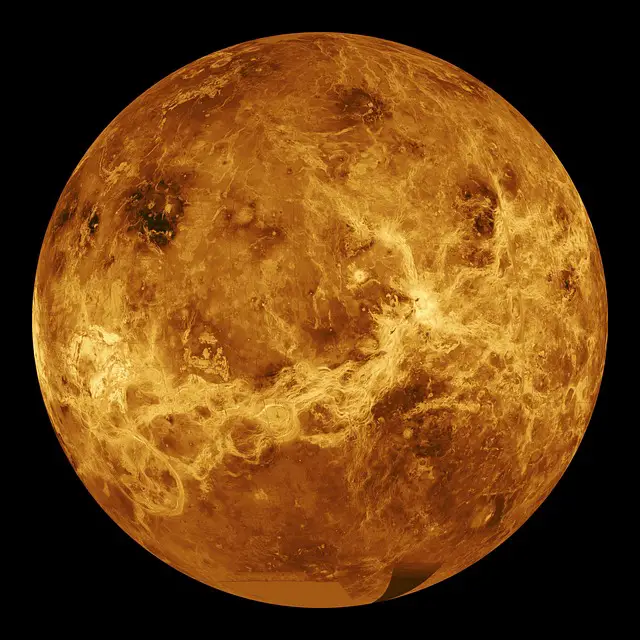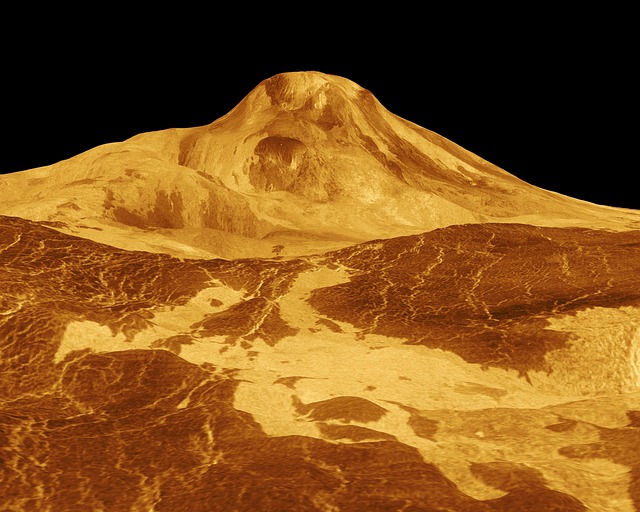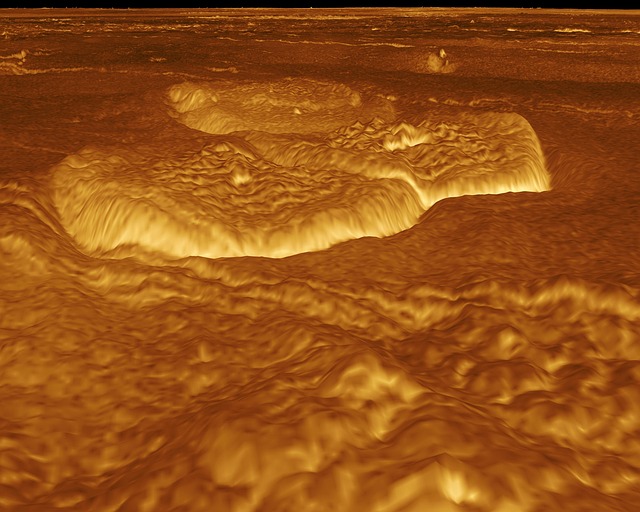The planet Venus is one of the most fascinating and mysterious planets in our solar system. With its thick, toxic atmosphere and extreme temperatures, Venus has captivated scientists and researchers alike. But what makes it so unique and intriguing?
Introduction
The size of Venus is approximately 0.95 times the size of the Earth, making it the second-largest terrestrial planet in the solar system. Venus has an extremely dense atmosphere composed primarily of carbon dioxide with clouds of sulfuric acid.
This atmosphere contributes to its very high surface temperatures, which reach up to 864 °F (462 °C). Venus also has a mass of 4.87 x 1024 kg, making it the second-most massive terrestrial planet in our solar system.
Venus has always been an object of fascination for humankind. In 1973, the Mariner 10 mission was the first to flyby the planet and take images of its surface. Since then, several missions have sent probes and spacecraft to further explore the planet and its atmosphere.
The Magellan mission used radar to map 98% of the planet’s surface in 1990 while more recent missions such as the Venus Express mission have studied the atmosphere and the planet’s climate.

Venus is also unique in its weather. The planet experiences violent winds, dust storms, and extreme temperatures. Its clouds reach altitudes of up to 37 miles (60 km) and can reach temperatures of up to 203 °F (95 °C). Venus also has an extremely slow rotation rate, taking 243 Earth days for one rotation.
The possibility of life on Venus has been a major area of research. Scientists and researchers have studied the planet for clues that life may exist on its surface or in its atmosphere. Recent research suggests that the possibility of life on Venus may be higher than originally thought, as new discoveries have been made about its atmosphere and its capabilities for sustaining life.
Despite all of the research that has been conducted on Venus, there are still many mysteries that remain unsolved. Scientists are still unsure about the origin of Venus’s atmosphere, its geological history, and the possibility of life on the planet.
These unanswered questions have left researchers and scientists with many theories and speculations about these unsolved mysteries.
From its size, atmosphere, and temperature, to the possibility of life on its surface, Venus has been a source of intrigue and mystery for centuries.
With ongoing research and exploration of the planet, we are gradually uncovering its secrets and surprises. Keep reading to learn more about the fascinating world of Venus.
Characteristics
Venus is a fascinating planet and its characteristics make it unique and interesting. It is the second planet from the sun and is the second brightest planet in the night sky. At a distance of about 108 million kilometers, it is a little closer to the sun than the Earth.
It is the hottest planet in the solar system and, because of its thick atmosphere, has a much higher temperature than other planets.
Venus is also the closest planet to Earth in size, with a diameter of 12,104 kilometers. This makes it the second-largest planet in the solar system, behind Jupiter. Its mass is 4.87 x 1024 kg, making it the sixth most massive planet in the solar system. Venus has a rocky core and a thick atmosphere made up of mostly carbon dioxide and nitrogen.
The atmosphere of Venus is incredibly thick and makes up more than 95% of its total mass. Its atmosphere is also very dense and is thought to be the reason why the temperature on Venus is so high. This atmosphere also makes it difficult to observe the surface of Venus from Earth.
The temperature on Venus is much higher than any other planet in the solar system. Its average temperature is 462°C, which makes it the hottest planet in the solar system. The atmosphere also causes a strong greenhouse effect, trapping heat and making Venus even hotter.
The clouds of Venus are made up of sulfuric acid droplets, which help reflect sunlight off the surface of the planet. These clouds also help to even out the temperature on Venus and protect the surface from radiation. Despite this, the surface of Venus is still very hostile and can reach temperatures of up to 471°C.
Venus also has a very weak magnetic field, which is believed to be due to its slow rotation. It is the slowest rotating planet in the solar system, with a day on Venus lasting for 243 Earth days. This is because it rotates in the opposite direction to most other planets.
Venus is an incredibly fascinating planet and its unique characteristics make it a compelling subject for exploration. Its high temperature, thick atmosphere, and sulfuric acid clouds make it a very hostile environment, but one that is ripe for discovery.
Its weak magnetic field and slow rotation also make it a fascinating study for scientists. From its size and mass to its atmosphere and temperature, Venus is an incredible planet that is full of surprises and mysteries.
Exploration of Venus
Exploration of the planetary neighbor – Venus – has been taking place for centuries. Our knowledge of the planet has advanced drastically with missions launched by different countries.
Rovers, satellites, and manned missions have all helped us to better understand the mystery of the planet, and the more we learn, the more fascinating it becomes.
Rover missions have given us the ability to explore the surface of the planet from afar. Through these missions, we can observe the terrain and landscape of the planet, and analyze the nature of its geology. Furthermore, rovers have been able to measure the temperature of the surface and analyze soil and rocks to learn more about the mysteries of the planet.
Satellite observations have also helped us to discover more about Venus. These instruments can measure the atmosphere and weather of the planet, giving us a better understanding of its climate.
We can also observe the clouds and winds of the planet, which provide further insight into its climate and weather patterns.
Spacecraft exploration is the most advanced form of exploration of Venus. Through these missions, we can monitor the atmosphere of the planet more closely. We can study the composition of the clouds and the effects of the solar wind on the planet’s magnetic field. Additionally, we can measure the temperature of the surface and analyze geological features.
These various forms of exploration have given us an incredible understanding of the planet, and have revealed many of its secrets. We now know more about Venus’s atmosphere and climate than ever before and can measure the temperature of its surface with greater accuracy.
We have also gained insight into the geology of the planet and are beginning to understand what makes it so special and unique in our solar system.

Venusian Weather
Venus is known for its extreme weather conditions, making it one of the most fascinating planets in the Solar System. Its atmosphere is composed of mostly carbon dioxide, with sulfuric acid clouds, and is filled with dust particles and electrically charged ions. The atmosphere is thick, and even though it rotates, there is very minimal wind.
The surface temperature of Venus is extremely hot, with temperatures reaching over 800 F. This temperature is caused by the atmosphere trapping the Sun’s heat and not allowing it to escape. The temperature also has an effect on the wind velocity, with winds rarely reaching more than 7 miles per hour.
Clouds play an important role in the weather of Venus. The clouds are composed of sulfuric acid which helps to reflect the Sun’s light, causing the atmosphere to remain cooler than it would be without the clouds. The clouds also help to retain moisture, creating a humid environment.
The clouds are also important for their role in protecting the surface of Venus from cosmic radiation. By blocking the radiation the clouds are able to keep the surface of Venus cooler than it would be otherwise, making it easier for spacecraft to enter the planet’s atmosphere.
Venus’s atmospheric pressure is also higher than the conditions on Earth. This pressure is due to the dense atmosphere, and the pressure can be upwards of 90 times higher than the atmospheric pressure on Earth. This higher atmospheric pressure helps to slow down the winds and make them more steady.
The weather on Venus has an enormous impact on our ability to explore it. With extreme temperatures, wind velocities, and atmospheric pressure, it makes it difficult to send spacecraft to the planet.
That is why we rely so heavily on satellite observations and rover missions to explore the planet and learn new information about it.
Life on Venus
The tantalizing question of whether life could exist on Venus has captivated researchers and the public alike for centuries. Despite its inhospitable atmosphere and high temperatures, there is a strong chance that some form of life may be able to survive on the planet’s surface.
The possibility of life on Venus largely relies on the presence of liquid water. Without water, it is unlikely that life could exist on the planet.
Surprisingly, there is evidence that liquid water once existed on the surface of Venus in the form of shallow oceans. Although the oceans have long since evaporated, the possibility of life in other forms has remained.
One possible habitat for life on Venus could be the planet’s clouds. The clouds of Venus are composed largely of sulphuric acid, but recent research has suggested that they may also contain liquid droplets of water. This environment could provide a refuge for unique forms of life, such as bacteria or other hardy microscopic organisms.
If life does exist in the atmosphere of Venus, it is likely to be extremely different from life on Earth, as it would have to adapt to extreme conditions.
Another potential habitat for life on Venus is the planet’s surface. Because of the hot and hostile environment, any life on the surface would have to be incredibly hardy in order to survive.
Some researchers speculate that microbial life could exist in the form of extremophiles, which live in extreme environments on Earth. This type of life could potentially be adapted to survive in the intense conditions of Venus’ surface.
The search for life on Venus is a difficult and challenging task. Due to the planet’s thick atmosphere, it is difficult to observe the surface from afar.
The most promising avenue of exploration is to send robotic missions to the planet’s surface, although this is a daunting prospect due to the hostile environment on the planet.
The question of life on Venus remains unsolved, but researchers continue to explore the planet and make exciting discoveries. It is possible that life could exist on the planet, but more research and exploration are necessary to answer the questions of what form it could take and how it could survive in such extreme conditions.

Unsolved Mysteries
Venus has been the subject of exploration and study since the invention of the telescope. And while many aspects of the planet are known to us, there are still a number of unsolved mysteries about Venus that remain to be uncovered.
One of the most perplexing mysteries of Venus is the fact that the planet once had oceans and a much denser atmosphere, similar to Earth. Despite the similar conditions, the two planets have evolved in drastically different ways. The reason for this discrepancy is still unknown.
Another mystery of Venus is why it is so much hotter than Mercury, despite the two planets being at a similar distance from the Sun. It is believed that the atmosphere of Venus plays a role in trapping the Sun’s heat, but the exact mechanism behind this is still a mystery.
The third mystery is why the surface of Venus is so flat. Venus has fewer significant topographic features than Earth, and the explanation for this is still uncertain.
The fourth unsolved mystery about Venus is its cloud coverage. The clouds of Venus are composed primarily of sulfuric acid, and the exact reason for their thick formation is unknown. This cloud coverage has been observed for centuries, and yet its source remains a mystery.
Finally, Venus has been the subject of speculation about the possibility of life. While the conditions on the planet’s surface make this highly unlikely, the existence of microbial life in the Venusian atmosphere has yet to be ruled out. Scientists are still searching for evidence of life on Venus, but the results so far have been inconclusive.
Despite these unsolved mysteries, scientists have made tremendous strides in understanding Venus. Further research and exploration should help to uncover some of these mysteries, and allow us to gain even more knowledge about this fascinating planet.
Conclusion
Venus has captivated us since the dawn of time, and its secrets have been revealed through exploration and discovery. Our understanding of the planet has deepened over time, but there are still mysteries to be solved and mysteries to be uncovered.
From its size to its atmosphere, Venus is a fascinating world with much to be learned. Its temperature and atmosphere make it an inhospitable place to live, but there is still the possibility that life could exist on the planet.
The exploration of Venus has come a long way, with rovers, satellites, and spacecraft all being used to uncover its secrets. We have also learned about its winds, clouds, and the potential impact of Venusian weather on exploration.
There are still unanswered questions about Venus, such as the possibility of life, possible habitats, and the challenges of finding it. Scientists are also exploring potential theories and future exploration plans.
To sum up, Venus is a fascinating world with much to learn about and explore. Its size, atmosphere, temperature, mass, and weather all make it a unique and interesting planet. We are still uncovering its secrets and figuring out the mysteries that remain.
The exploration of Venus is an ongoing project, and there are sure to be many more discoveries in the future. We can only imagine what those discoveries might be and the potential theories they could bring. No matter what, we’ll be sure to keep learning about this fascinating world.
Links
We have a variety of facts about Venus here – Various facts about the planet Venus

